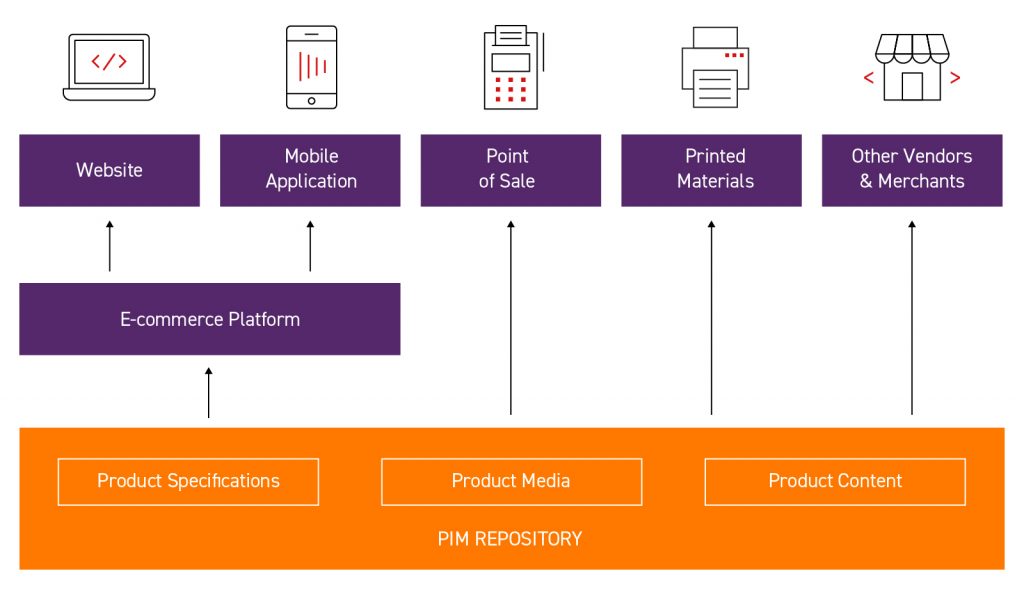Pimcore vs Akeneo / The Best PIM Software?
E-commerce and retail companies sell products – and each product has a wealth of information that needs to be maintained. These days, Product Information Management tools are plentiful. We’re not going to tell you what they do – the clue’s in the name and we already covered it 😉 – but advise you on the next step: how to choose the best PIM software for your needs.
Specifically, we’re going to look at what we – and many others – consider to be the two best-in-class options: Akeneo and Pimcore. We offer both options to clients, based on what we think is right and what really works in day-to-day operations.
Product Information Management Requirements
Before we begin, let’s go over what it is we actually want from any top PIM software. PIM solutions are essentially a subset of Master Data Management that directly specialized for product-based needs (although we’re primarily assessing them in regards to e-commerce), so they are used to enable your teams to add or update data once, with automatic updates in both your own system, as well as external vendors and marketplaces. They’re a Single Source of Truth for your goods.

With that in mind, we’re looking at these specific Product Information Management requirements:
- Pricing & costs. Every solution is a calculated investment, so we still need to consider Pimcore pricing plans vs Akeneo pricing plans.
- Features. By this, we mean the features and capabilities beyond the basic “PIM” concepts of data entry and consistency.
- Integration and compatibility. How does each tool connect to other systems? Are there any barriers? Spoiler: Nope. Not really.
- Usability. Even the best PIM software still needs to be user-friendly for the humans that have to… you know, use it.
- Long term support. Future support is essential. How actively the PIM is updated and the maintenance required are both key factors to be considered.
About Pimcore
Available since 2013, Pimcore is an open-source data solution based on PHP. It serves multiple master data management uses but, as the name suggests, it’s primary focus is Product Information Management.
Pimcore is available in multiple variants. The “main” version has both a free Community Edition and a premium Enterprise Edition, while there’s also a third Cloud-included option that has three tiers of its own, that differ in the range of data management capabilities (Starter, Professional and Ultimate).

About Akeneo
Available since 2013, Akeneo is an open-source data solution based on PHP. Yes, that’s identical to Pimcore. However, where Pimcore goes wide with master data practices, Akeneo focuses exclusively on product data.
Currently, Akeneo comes in three versions; a free Community Edition, a premium Enterprise Edition (Saas/ PaaS) and a Growth Edition (SaaS) that lacks the advanced features of the latter, but has the updates and support that the former Community Edition lacks. The latter is a surprisingly suitable half-way house for companies to advance from the free version before they’re ready to jump into the full-fledged Enterprise Edition.
Akeneo vs Pimcore / PIM Comparison by Requirements
Now the basics are covered, let’s go through the previously mentioned requirements to find any key differences.
Pricing & Costs
Both Akeneo & Pimcore have free community editions, so if you’re a fan of open-source projects, you can always try the free version. Of course, open-source options require a lot more work to get the best results, so you need to add these additional costs.
However, it’s important to note that the free, open-source versions include all the common functionalities the average e-commerce store or business needs. The Enterprise Editions are useful when your business model needs something very specific, such as PDF generation or Web2Print.
Neither Akeneo or Pimcore disclose the Enterprise pricing plans, but from our experience, Pimcore has a higher ceiling. That being said, Pimcore covers multiple publishing channels – here referring to when product data needs to be directly different for the likes of mobile apps, websites and even print media* – while Akeneo’s licensing model increases with additional channels after the first two. This arguably gives Pimcore a cost-efficient distinct advantage for e-commerce stores with an omnichannel business model.
*So, if your data and information is identical across every app, catalogue, site or marketplace, then you only need one “channel”. Maths! Logic!
Features
As expected, both Pimcore and Akeneo include the essentials for storing product information and descriptions… but what else? Both also offer the necessary photo and media needs, as well as product relationships, necessary for defining supplementary, complementary and competitive products (useful for advanced needs, such as recommendation engines, for example).
* You may need an additional channel only if you want to have different values for the same attribute of a given poduct. For example – you can send information to mobile or 5 e-commerces etc. while having only 1 channel, and you can have 2 channels if you only have mobile and 1 e-commerce.
**Both Akeneo and Pimcore support unlimited use of locale codes in the form of known language and country combinations, e.g British English (en_GB), Canadian English (en_CA) and Canadian French (fr_CA). Going back to the MDM roots, this is essential a data field that can be added to products as listed.
Integration Abilities
Both Pimcore and Akeneo are very open for integration – by their very nature, they have to be. However, on the technical front, both do so in different ways. Pimcore prefers GraphQL, while Akeneo uses its REST API.
Both GraphQL and REST API achieve the same goals here so, attributions aside, there isn’t a clear winner. Most developers tend to prefer the latter so, if your goal is to keep your development teams happy, this might be something to keep in mind.
Compatibility
From a technical perspective, Pimcore’s reliance on MySQL (as it’s built around GraphQL, as shown above), might bring some limits if you wanted to use, for example, an Oracle Database. Akeneo API, on the other hand, uses the wonderful land of API; in our experience, this seldom causes any problems. As headless solutions, both will easy work with your other systems.

Usability
When it comes to Akeneo vs Pimcore in terms of usability, there is a noticeable difference. Pimcore is open-source, but designed for wider data needs. As such, it’s less “user friendly” for marketing or product teams, for example, while developers are also needed to create any required reports.
Akeneo, on the other hand, is built around more specific Product Information Management requirements and the people who use them – i.e, less technically-skilled teams.
Long Term Support
On both Enterprise editions, Pimcore and Akeneo support businesses well, with Service Level Agreements under the license. There’s not much more to say here – both have a history of being well supported.
Akeneo vs Pimcore / Final Thoughts
At a basic PIM comparison level, both Akeneo and Pimcore suit e-commerce needs just fine. They work will with all modern e-commerce platforms and are pretty adaptable to most needs. So, what’s the big difference?
Pimcore is much more technical. Because it’s built for more advanced data needs, it has more wiggle room in terms of flexibility, but this comes at the cost of up-front work. That said, if you’re looking to build omnichannel, international or even multibranded operations, Pimcore may be more versatile.
It’s also ideal for companies with more advanced needs or niche requirements, as it’s much more customizable from the get-go. Yet the cost of this is a “jack of all trades” scenario. Getting the most out of Pimcore in this manner requires significant amounts of work. Unless you’re passionate about reinventing the wheel, there are other digital experience, content management and data tools that are better at their respective areas.
However, if you’re a dedicated e-commerce with more direct needs, Akeneo’s user-friendly approach can make it much more appealing, but it’s pricing system might impact you later on if you have really expansive ambitions. Compared to other systems in this class, it is still competitively priced. As a more streamlined PIM, it’s better suited for companies focusing mostly on the retail and direct consumer-facing business.








